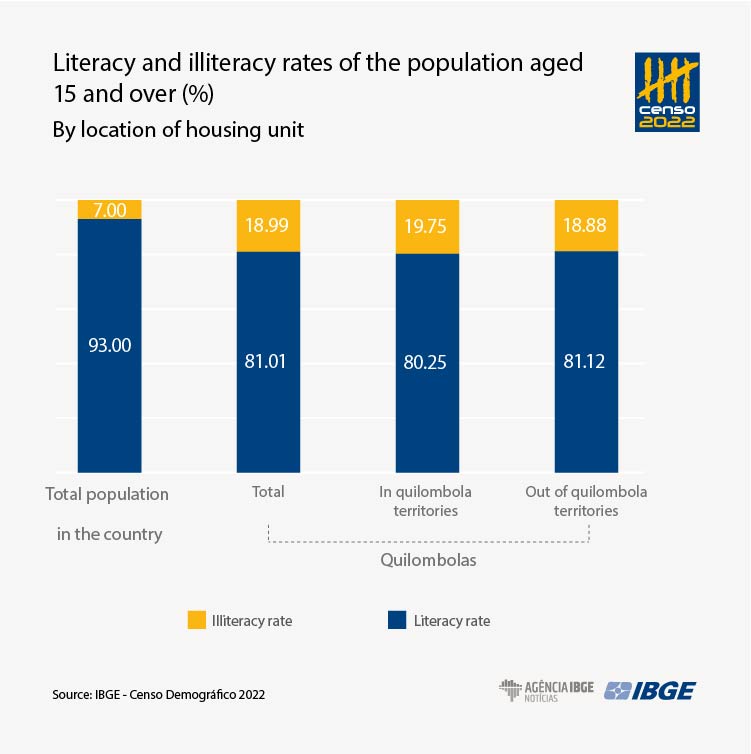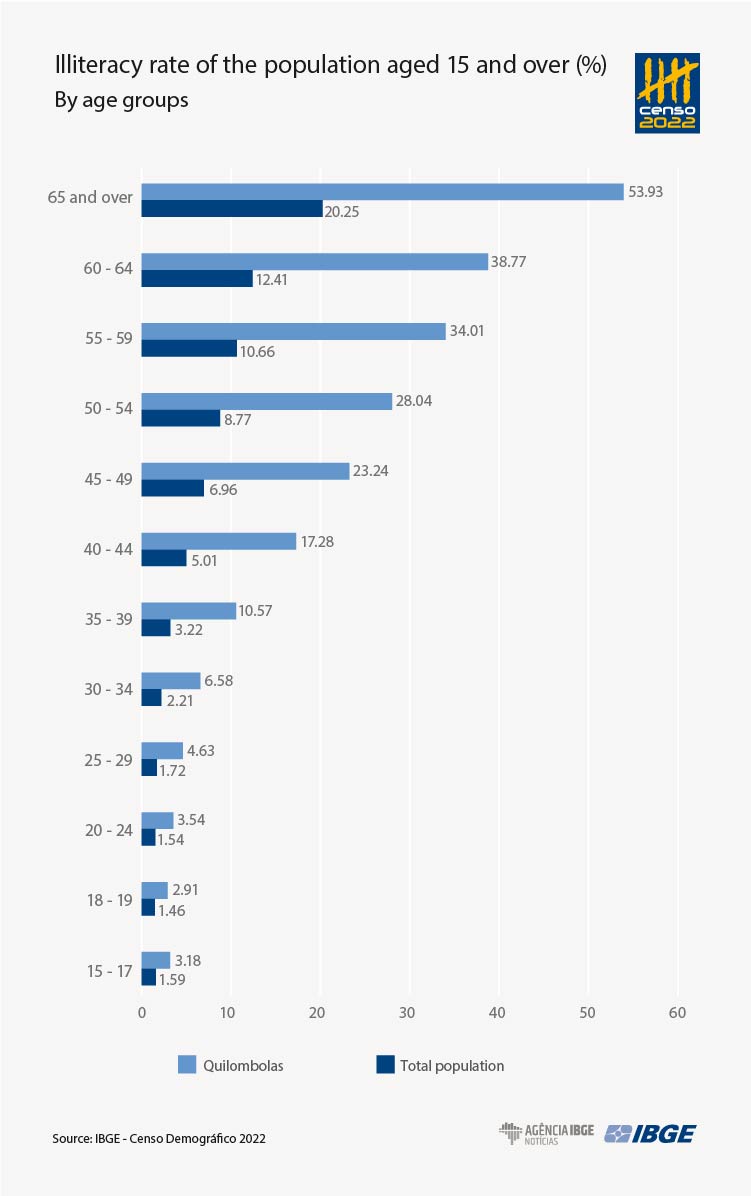2022 Census
2022 Census: illiteracy among quilombolas surpasses by almost three times that of the total population
July 19, 2024 10h00 AM | Last Updated: July 23, 2024 01h42 AM
Highlights
- In 2022, 1,015,034 quilombolas aged 15 and over lived in and out of official quilombola territories. A total of 81.01% (822,319 persons) were literate, and the remaining 18.99% (192,715 persons), illiterate. So, the illiteracy rate of quilombolas aged 15 and over was 2.7 times higher than that of the total resident population in Brazil.
- Inside official quilombola territories, the illiteracy rate of quilombolas aged at least 15 hit 80.25%. This figure is lower than the overall literacy rate of quilombolas (81.01%), and the literacy index of the total population in this age group (93.0%).
- The illiteracy rate of quilombolas aged 15 and over, against the same index relative for the total resident population aged 15 and over in Brazil, was higher in all the aged groups.
- Quilombola women (82.89%) had an illiteracy rate above that of quilombola men (79.11%). This difference of 3.78 percentage points is higher than that for the total population of the country, which amounted to one percentage points (93.48% of men and 92.49% of women).
- The higher illiteracy rate for the quilombola population were found in the South (89.96%), North (87.45%) and Central West (86.56%). The lowest rates were those of the Northeast (78.40%) and Southeast (85.32%). Against the total population in Brazil, quilombolas had a lower level of literacy in all the Major Regions.
- The biggest difference between literacy rates of quilombolas (85.32%) and of the total resident population in the country (96.08%) was observed in the Southeast, where it reached 10.76 percentage points.

According to data collected by the 2022 Population Census, the illiteracy rate of quilombolas aged 15 and over, living in and out of official territories (1,015,034 persons), was 81.01% (822.319 persons), below the national index (93.0%) for this age group. So, the illiteracy rate of quilombolas reached 18.99% (192,715 persons), 2.7 times above that of the population overall (7.0%). Literate persons, in the survey, were the ones able to read and write a simple note.
These results were released today (19) by the IBGE in “2022 Population Census – Quilombolas: Characteristics of housing units and literacy: Population results.” The Institute has also released today “2022 Population Census: Quilombola Localities.” Therelease event is scheduled for today, at 10 am, at Escola Municipal de Tempo Integral Negro Cosme (a full-time school), located at the Liberdade neighborhood, in São Luís (MA). The event will be streamed live on Digital IBGE.
You can also read the article on characteristics of housing unitswith at least one quilombola resident and the one on quilombola localities.
In official quilombola territories, there were 122,227 persons aged 15 and over in 2022. The illiteracy rate for this group was 80.25% (98,091 persons), below the national rate for this parcel of the population (93.0%) and also below the literacy level for the quilombola population (81.01%). As a result, the illiteracy rate reached 19.75% (24,136 persons), a level above the national rate (7.0%) and above the percentage of illiterate persons in the quilombola population (18.99%).
Of the total quilombolas aged at least 15 who lived out of the quilombola territories in 2022 (892,807 persons), 81.12% (724,228 persons) were literate. This figure was below the national rate (93.0%) for the same age group, and a little above the literacy index for the entire quilombola population (81.01%). Therefore, 18.88% (168,579 persons) of this population group were illiterate, above the national average (7.0%), but with an illiteracy rate below that found among the quilombola population (18.99%).
“The literacy status of quilombolas does not differ significantly in terms of location of the housing unit, inside or outside the official quilombola territories. When the group of quilombola persons is considered, this difference amounts to one percentage points only,” remarks Marta Antunes, coordinator of the Census for Traditional Peoples and Communities.

Illiteracy reaches mainly older quilombola persons
Illiteracy among quilombolas aged 15 and over, against the illiteracy rate of the total population in Brazil for the same type of analysis, is higher for all the age groups. “That evidences the existence of fewer opportunities for quilombolas in relation to the resident population in the country,” Marta Antunes explains.
The status of illiteracy among quilombolas can be better understood considering disaggregation by location of housing unit – rural or urban, which is expected to be released in coming months, after the processing of more 2022 population Census results. “It will be possible to contextualize more precisely the illiteracy rates and the illiteracy rates for quilombolas and for the total resident population.”
According to the 2022 Census, as observed for the resident population in Brazil, the illiteracy rate of quilombolas increases with age. In quilombola territories, however, there is a bigger increase. The analysis of the quilombola group shows that, up to the age of 29, the difference between the illiteracy of the resident population and of the quilombola population was below three percentage points. In Other age groups, this difference increased significantly, and reached 33.68 percentage points for persons aged 65 and over. .
Coordinator Marta Antunes says that “there are more educational opportunities for younger than older generations, due to the expansion of access to education in recent decades.”
On the other hand, the illiteracy rate of quilombolas living in official quilombola territories and out of these areas differ by up to one percentage points, approximately in age groups below 44 years of age, with an increase of this difference for persons aged 45 and over. “This reality can be seen as a liability of Investments in basic education in past decades, inside quilombola territories that had higher illiteracy rates.”

Literacy rate of quilombola women is higher than that of quilombola men
Quilombola men registered a literacy rate of 79.11%, which is 3.78 percentage points lower than the literacy rate for Quilombola women. This is a wider difference than that found in the total population, which was one a literacy rate percentage point higher for women than for men.
The difference in the literacy rate between Quilombola men and women was somewhat greater among Quilombolas living ou of the official Quilombola territories, where men had a rate of 79.18% and women, of 83.02%, or 3.84 percentage points. Within the official territories, the gap was 3.74 percentage points, with Quilombola men achieving a literacy rate of 79.11% and women, of 82.89%.
The literacy rate of Quilombola people by sex and age group showed that Quilombola women have a higher literacy rate in all age groups, except for those over 65, in which the literacy rate of Quilombola men was higher (3.78 percentage points higher). The biggest differences (8.30 percentage points) were found in the 45 to 54 age group. Only in the 65 and over age group men did men have a higher proportion of people who could read and write, 47.38%, compared to 44.87% for women.
Although the total population of Brazil showed a similar trend, the literacy rates of Quilombola women were lower than those of women living in the country, whose lowest rate was 79.6% for the group aged 65 and over. This figure was higher than the literacy rate of Quilombola women in the age groups 50 and over.
The literacy rate of Quilombola people by sex and age group, by location of housing unit (in or out of official Quilombola territories), showed the same pattern, with Quilombola women having higher literacy rates in all age groups. The exception was the over-65s, where the literacy rate for Quilombola men was higher, regardless of the location of the housing unit.
Difference between the literacy rates of quilombolas and the total population of the country is greater in the Southeast
In regional terms, the highest literacy rates for quilombola people were recorded in the South (89.96%), North (87.45%) and Central-West (86.56%). The lowest rates were found in the Northeast (78.40%) and Southeast (85.32%). It is worth noting that 68.14% of quilombola people lived in the Northeast, where the literacy rate is lower, having a significant impact on the literacy rate of quilombolas in the country.
When the literacy rates of quilombolas were compared with those of the total resident population in Brazil, it was observed that, in all the Major Regions, the rate of the quilombola population was lower. The biggest difference was seen in the Southeast, with the literacy rate of quilombolas being 85.32%, and that of the total resident population 96.08%, i.e. 10.76 percentage points lower. The second largest difference was found in the Central West (8.38 percentage points), followed by the Northeast (7.39 percentage points)).
The analysis of literacy rates of quilombolas living in and out of official quilombola territories showed that, with the exception of the Central-West and Northeast, the rates were close, with less than two percentage points difference. In the Central West, the literacy rate in official quilombola territories was 81.27% and out of them87.49% (a difference of 6.22 percentage points), while in the Northeast the literacy rate in official quilombola territories was 75.65% and out of them 78.69% (a difference of 3.04 percentage points).
In all the Major Regions, for all age groups, the illiteracy rate for quilombola people aged 15 and over was higher than that of the total population living in Brazil in the same age group in 2022. As for the population living in official quilombola territories, in the North and Central-West, for all age groups, the illiteracy rate for quilombola people was higher. In the Northeast, the trend remained the same in all groups, except for 18 and 19 year olds, where the rate was closer, with 3.25% in and 3.28% of illiteracy out of quilombola territories. Meanwhile, in the Southeast, the illiteracy rate of quilombolas living in quilombola territories was lower than that of quilombolas living out of them, in the age groups below 25 years old. In groups aged 25 and over, this scenario is reversed.
The 2022 Census also revealed that 20.26% of the municipalities with quilombolas had differences of more than 10 percentage points (up to 67) when the illiteracy rate of quilombola people are compared with the illiteracy rate of the population living in the country. In addition, 81.58% of the municipalities with quilombolas showed levels of illiteracy of quilombola people above those of the total resident population in Brazil.
“In 310 municipalities, the literacy rate of the quilombola population was higher than that of the resident population as a whole. This was identified in the North, Northeast and, above all, in the South and Southeast. The greater access to central areas, with more education on offer, is a possible explanation. In addition, these are municipalities which, in general, have smaller quilombola populations,” says Fernando Damasco, the manager for Traditional Territories and Protected Areas.

More about the survey
The Population Census is the most complete statistical operation in the country, covering all the 5,570 Brazilian municipalities. The first results of the 2022 Population Census for quilombolas were released in July 2023 and are available on the IBGE News Agency. Asecond round of results was released in December the same year, and counted 1,330,186 quilombolas in 25 Federation Units. In May 2024, demography for the quilombola population in Brazil was inaugurated, with releases of analyses by sex and age.
The publication “2002 Population Census: characteristics of housing units and literacy, by specific territories – population results” presents information such as sanitation conditions of housing units with at least one quilombola residents, in and out of official Quilombola for Brazil, Federation Units, Municipalities, Legal Amazon by Federation Units, official Quilombola Territories and Quilombola territories by Federation Units.
The data are also available at the Geographic Interactive Platform (PGI), no 2022 Census Overview and Sidra.




















